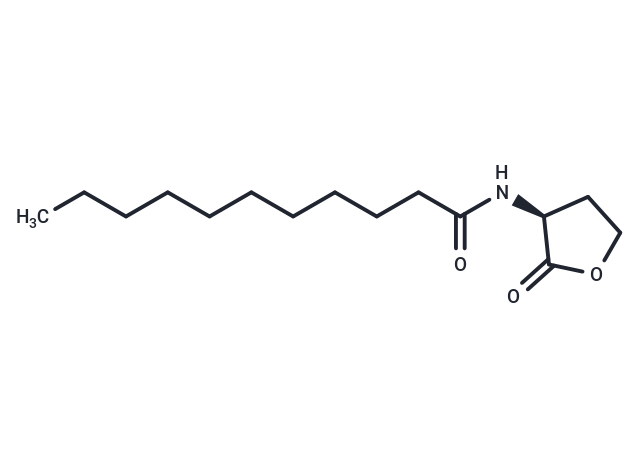- Remove All
 Your shopping cart is currently empty
Your shopping cart is currently empty
N-undecanoyl-L-Homoserine lactone
N-acylated homoserine lactones (AHLs) are a class of autoinducers used in bacterial quorum sensing to control gene expression in response to cell density. These molecules, comprising a fatty acid coupled with homoserine lactone (HSL), vary in acyl group length (C4-C18), C3 substitution (hydrogen, hydroxyl, or oxo group), and the presence of carbon-carbon double bonds, determining signal specificity through LuxR family transcriptional regulators. C11-HSL, with its rare odd-numbered acyl carbon chain, may act as a minor quorum-sensing signaling molecule in P. aeruginosa strains. Regulating bacterial quorum sensing can inhibit pathogenesis and represents a novel antimicrobial therapy approach for infectious diseases.

N-undecanoyl-L-Homoserine lactone
| Pack Size | Price | Availability | Quantity |
|---|---|---|---|
| 5 mg | Inquiry | 35 days | |
| 10 mg | Inquiry | 35 days | |
| 25 mg | Inquiry | 35 days | |
| 50 mg | Inquiry | 35 days |
Product Introduction
| Description | N-acylated homoserine lactones (AHLs) are a class of autoinducers used in bacterial quorum sensing to control gene expression in response to cell density. These molecules, comprising a fatty acid coupled with homoserine lactone (HSL), vary in acyl group length (C4-C18), C3 substitution (hydrogen, hydroxyl, or oxo group), and the presence of carbon-carbon double bonds, determining signal specificity through LuxR family transcriptional regulators. C11-HSL, with its rare odd-numbered acyl carbon chain, may act as a minor quorum-sensing signaling molecule in P. aeruginosa strains. Regulating bacterial quorum sensing can inhibit pathogenesis and represents a novel antimicrobial therapy approach for infectious diseases. |
| Molecular Weight | 269.385 |
| Formula | C15H27NO3 |
| Cas No. | 216596-71-3 |
| Storage | Powder: -20°C for 3 years | In solvent: -80°C for 1 year | Shipping with blue ice. | |||||||||||||||||||||||||||||||||||
| Solubility Information | DMSO: 25 mg/mL (92.8 mM), Sonication is recommended. Ethanol: 1.5 mg/mL (5.57 mM), Sonication is recommended. DMF: 20 mg/mL (74.24 mM), Sonication is recommended. | |||||||||||||||||||||||||||||||||||
Solution Preparation Table | ||||||||||||||||||||||||||||||||||||
Ethanol/DMF/DMSO
DMF/DMSO
| ||||||||||||||||||||||||||||||||||||
Calculator
In Vivo Formulation Calculator (Clear solution)
Dose Conversion
Tech Support
Keywords

Copyright © 2015-2025 TargetMol Chemicals Inc. All Rights Reserved.




